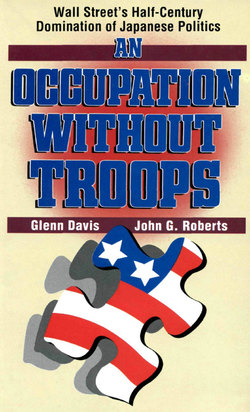Читать книгу Occupation Without Troops - Glenn Davis - Страница 6
На сайте Литреса книга снята с продажи.
ОглавлениеAcknowledgments
This work came together over a twenty-year period of researching how the elites of the United States and Japan interact. So many people helped in the research it would be impossible to mention them all here.
Much first-hand knowledge about the reclusive, semi-secret American Council on Japan was provided by those who either participated directly in the group or who were connected with its activities. One ACJ participant, Takeshi Watanabe, pointed out mistakes and incorrect conclusions in our manuscript, and even provided copies of personal letters to and from Kay Sugahara, which helped our research immensely. Although not involved directly in the ACJ, ex-diplomat Toshiro "Henry" Shimanouchi also provided letters and photos. We are grateful to both men for their invaluable assistance.
In the latter part of the story, which deals with private diplomacy and the activities of semi-secret groups such as the Trilateral Commission and the Council on Foreign Relations, we are grateful to Tadashi Yamamoto for his patience and understanding. Although basically disagreeing with our analysis, Yamamoto San was big-9 hearted and liberal enough to read our manuscript, adding his comments and criticisms. He also provided photos from a TLC meeting in Tokyo, all of which added a great deal to the accuracy of our text on his Japan Center for International Exchange.
We would especially like to thank several professors in both countries for their assistance and support; Marius Jansen, Chalmers Johnson, Michael Schaller, Herbert Bix, and Eiichi Shindo. John Roberts' old friend and pen pal Howard Schonberger, the late professor from the University of Maine, did much of the groundbreaking research on the ACJ and should be so credited. He gracefully shared his research with us and for that we are grateful.
Many discoveries about the ACJ and its nefarious activities resulted from conversations with fellow journalists at the Foreign Correspondents Club of Japan over the years. We would like to thank Robert Whiting, Greg Davis, Dennis Holden, Tim Porter, Murray Sayle, Peter Hadfield, Peter McGill, Tom Gill, and many others. The late and great Mainichi journalist Koji Nakamura provided much of the original inspiration to tell this story, even though we could find no publisher during the chilly Cold War period. The librarians at the Foreign Correspondents Club should also be mentioned for their categorical memories, which helped greatly in locating published materials.
The authors express special thanks to writer David E. Kaplan for his consistently accurate analysis and criticism. His understanding and feel for describing unseen forces at work in both Japanese and American society were immensely helpful in the preparation of the final manuscript. His success with Yakuza and Fires of the Dragon was a special inspiration.
Special thanks is also extended to old Japan hand and author Boye Lafayette De Mente, and to radio talent Matt Shea, for kindly proofing the final draft. Kudos also to translator for the Japanese version, Naomi Moriyama (nee Matsuzaka), who not only rendered the manuscript into lively Japanese but also acted as an editor for the English version, making invaluable suggestions on how to re-arrange the text for better readability. She also checked on the accuracy of Japanese spellings, dates, and much more, far beyond the call of duty.
Finally, I would like to add a special thank you to all those fine people in the American Chamber of Commerce in Japan who read our manuscript. Thanks especially to Glen Fukushima, who knows the story well, and to Robert "Skipp" Orr, whose specialized knowledge of Japan gave us new insights into familiar territory. Lastly, thanks to Pam Warnken, the public affairs officer at Atsugi Naval Air Station who provided historical files on the base's history and photos of General Douglas MacArthur, when he first landed in Japan.
Photos appearing in the book are courtesy of: 1. The Daily Yomiuri; 2. Mainichi Newspapers; 3,4. The Foreign Correspondents' Club of Japan; 5. Visual Arts International; 6. Public Affairs Office, Atsugi Naval Air Station; 7,8. The Japan Center for International Exchange; 9,10. Visual Arts International; 11,12. Toshiro "Henry" Shimanouchi; 13,14. Mainichi Newspapers; 15. United Press International; 16. Visual Arts International; 17-20. Kyodo Photo Service.
